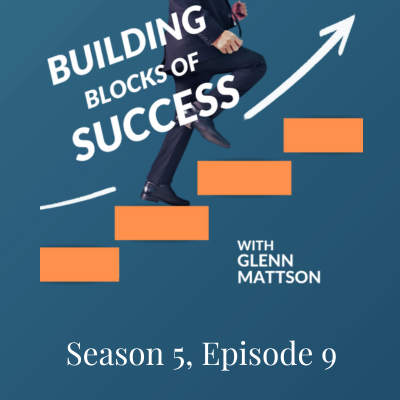
The content of this recording is copyrighted by Sandler Systems LLC. All rights reserved.
Glenn Mattson
Well, welcome back everybody. We had a great conversation in episode eight regarding your individuals, your people, and how to onboard them. But I've gotten a lot of emails and input, so I want to do a real quick version of what that looks like for today. So when we take a look at the Rainmaker, what are they looking at and how are they going to be taking a look at developing themselves in the near future? One of the critical things is having the ability to delegate, and delegation is absolutely critical for growth. So I want to talk a little bit today just about the process of delegation and some of the keys that I want to make sure that we all have when it comes to delegation now when we look at really what our responsibility is and what are we are the ones that need to be doing on a consistent process.
Glenn Mattson
For many of us, it could be things like prospecting, qualifying, closing, presenting account management, developing relationships, etc. But there's an enormous amount of things that behind the scenes need to be done, and as an emerging advisor or emerging entrepreneur, we did many of those things on our own, and we multitasked, and we spent many hours doing those, and we, as I talked about last time, is really looking at time profitability. Time profitability is, how we actually delegate, which is absolutely critical for growth, to other individuals or things that we used to do on our own so that we can really take the time that we've delegated and move it back into what we consider paid time activities.
Glenn Mattson
So, last time I talked about paid time and no pay time, and I really think that's one of the most critical aspects of growth when we look at developing and creating team members. And how do you really build the business? So when as a rainmaker, one of the things that you look at is, what are the no-pay time activities that need to be done? What are the no-pay time activities that are exceedingly time-consuming but can be delegated to somebody else, you're going to start to realize, as you get to the CEO level, that pretty much everything in the business can be delegated. But for right now, I want to just spend time on that Rainmaker who's in the early phases of going from a really that level of getting into the Rainmaker.
Glenn Mattson
You're starting to look at the individuals that we need to have to really grow the business. You know, the developing entrepreneurial is, is really someone who has maybe one or two people, but they're very comfortable with one of those one or two people, and it's more of a lifestyle business, as we talked about. So the rainmaker is that individual that is now looking to grow, they're looking to expand their skill sets, which is creating rain, but they have an awful lot of tasks and responsibilities that need to be done, and they're going to be done by somebody else. So I know in Episode Seven, I went into some detail on how to do that, and I've gotten, again, a ton of questions and input and emails regarding it. So I wanted to spend a couple of minutes with you on just an easy breakdown on how to really take a look at what you can do to create a role, understand the responsibilities, how to actually interview somebody for it, and then how do you onboard them for it?
Glenn Mattson
So, let's go through it pretty quickly and make sure that we have the keys to this. So the first part is, really what is their role? And you have to ask yourself, is it going to be a single role, or is it going to be multiple roles? Sometimes individuals on your team may wear multiple hats, and if they wear multiple hats, those are going to be done in multiple different roles. So what I'm going to be talking about is per role, right? So you may have someone who does scheduling, you may have someone who does onboarding of clients, you may have someone who does paperwork, and that's all for one individual, but that's really three different roles, and each role, it's important to realize so no matter if they have a single role or multiple hats, take a look at each of those roles and ask yourself, what are the responsibilities?
Glenn Mattson
Okay, now, a responsibility is really what do they own? What are they ultimately going to have to do at the level that you want it done by, so that you have honestly ease of mind that is being done the way it needs to be done, how it needs to be done? So the first piece is really breaking down, what are the roles that you're expecting them to do, and then below that is what are the responsibilities within that role that you're looking for? And being obscenely clear on what your responsibilities are is really going to make this process easy. So if you're sitting there trying to create, knowing that you're growing, knowing that you have to fill in some spot spots, what's the best thing for me to do? Well, just sit there and say, okay, What? What? What do I need to get done? And more times than not, that is the responsibility. And you can create the role backward if you want. But there are two different things.
Glenn Mattson
So a role is, in essence, a title, and the responsibilities are the actions or expectations of what they're supposed to do. Now, with that being said, there are a couple of things, and that in itself, is a task for many people, and it takes them two or three or four iterations, sometimes just to get it really down to the basics, right? So now, when you finally understand the roles and responsibilities, the next thing I want you to take a look at is the process.
Glenn Mattson
This is where, honestly where most entrepreneurs, some have an issue, where they're, you know, the gunslingers. They live by tracer bullets, they do and then they have process around them, but the process isn't documented, so you gotta understand that process runs your business. And when you bring on people, you onboard people, the better you are at laying out what the process is the easier it is for them to learn to process one of the most ridiculous things that unfortunately many people do is, well, just watch me do it. You can see me do it two or three times, and after that, I expect you to pick it up. Well, my gosh, you've been doing it that way for as long as you've been doing it. You're an expert. You don't even think about it anymore, and you're expecting someone just to watch you two or three times then get it and or, you know, after they do that, then they get angry or upset or frustrated when things aren't getting done. The only note when things aren't getting done is when they are aware of the gaps of things not being done, and they go back and then teach them well, this is how you make sure you do it right.
Glenn Mattson
So take the time to slow down and write out what the process is. Step one, step two, step three, step four, what do you need to know? Where do you need to go to get it? Where do you need to go to get the answers? If you don't know how to do it or you get stuck, so process is pretty critically important. So roles, responsibilities, processes, they need to know and make sure that when we talk about process, that it's instructional, right? Don't rely on memory. Have a workbook, have Learning Guides. There are many different things in today's world that you can use through AI and the technology that makes it incredibly easy, or a lot easier than it used to be, to learn all this stuff and put it into some documentation. Now when you actually have your process done, the other one I want to share with you is the values, the beliefs, and the behaviors.
Glenn Mattson
So what are the most important values that you want the team to express? What are the obligations to your clients that you think are critical communities to each other? What are the personal qualities you want to make sure that they have? How are they going to display these personal qualities within the activities and the consistent behaviors of what they do? So, you know, for instance, if honesty, integrity, and is a value of yours, then the belief is that we value honestly. We believe that we should be transparent in our interactions with our clients and others. Well, the behavior is that they're going to value honesty. And when someone makes a mistake, you own it, but you know so we make sure that your values, your beliefs, and your behaviors are connected.
Glenn Mattson
Now realize everything I'm sharing with you right now is in this podcast. If you need help, just reach out to us at Glennm@sandler.com more than happy to share it with you and send it to you. It’s at the transcript at the bottom. We have documents for this, tools for this, to help you understand what the roles are, to help you understand the responsibilities, to lay out what the processes are and sequential steps, etc. But one of the best exercises I've found is one of the ones that we have called the values, beliefs, and behaviors, exercise, and I often found it, especially with teams that are merging or the teams that are growing. One of the first things I do is the value exercise.
Glenn Mattson
You'll notice that whenever there's conflict inside of a team, almost all. Their values, their beliefs, or their behaviors are not aligned. So make sure that when you're working with and creating this role and the responsibilities that you identify, what are the values, what are the beliefs and the behaviors that you think are pretty critical? Okay, now, by actually having the right mindset. Because more times than not, the people that you have on board, the ones that you say, like, I was talking with a client yesterday that said, Oh my gosh, I have finally found the Holy Grail. She's absolutely amazing. She leans in, we don't have to give her much instruction, and she gets things done. She takes the next step. So she's doing all these things that honestly, they got lucky, versus putting down those values and the beliefs, that they have an alignment to the values and beliefs.
Glenn Mattson
When you really look at your team, what I want you to look at is energy. How much energy does it take to work with this person, how much energy does it take to develop this person? How much energy does it take to supervise this person? And if you have someone historically with the right values and beliefs and connected to the right behaviors, that will demonstrate that it doesn't take a lot of energy to work with them and develop them. So now that we have the role, the responsibility, what processes they need to know and own, the mindset that's now going to get us into the interview questions. Now a couple of things I want to share with you about interview questions. These are more rules, benchmarks, things to think about, and things to jot down.
Glenn Mattson
The first is, to stop selling the position. Stop telling people what the job is. Stop sitting there telling them this is what our expectations are. Can you do it? What you want to make sure is that you have the ability to interview the candidate. It's very important. It's a massive difference between selling a position and interviewing a candidate. Now, one of the things that you have to realize is that most people do an okay job of interviewing, and they'll say, well, they have a history of doing it, so, therefore, they'll be good here just because someone did paperwork someplace else or did a great job with territory management or CRM does not mean they're going to fit your company and or you so make sure that your interview questions are really critical based on your expectations of their responsibilities, And with that, do they fit the values.
Glenn Mattson
So, for instance, if you want someone who's exceedingly good at multitasking, well, are you looking for someone that works start, you know, from beginning to end on a task and can only do one task at a time, or are you looking for someone who can juggle and do a lot of different things, but not lose sight of what they put down to pick something else up and they get it all done. Okay, so, you know, an interview question could be something as easy as, you know, historically, in this kind of role, I find there are two different types of people.
Glenn Mattson
One is someone who is exceedingly well at what they do, but they're kind of a start-and-end type of individual, where they start a task and they like to do it from beginning to end, and they pick up another task. Then there are others who can do, you know, more of a juggle, which is, they can handle a few things, but when they go to another task, they don't forget to go back to the original task. Do you mind if you share with me, which one fits more like you? And all of a sudden, if they tell you, well, I can multitask and say, well, that's fantastic. I appreciate that but manage to share with me a little bit about how you remember to do what you're supposed to do when you're done doing one task to pick up another. How do you make sure that you don't drop the ball and remember that when you're doing your interview questions, nothing is found out in one question? It's always three deep meaning that you have your initial question, your next deeper question, and then ultimately it's the juicy question at the end.
Glenn Mattson
So I would highly suggest that you write out your questions. Don't wing this. It's incredibly important when you interview two or three different people, you want to look at your interview questions and take a look at how each person interviewed based on those questions. It's very common that if you find something that is common to the person that you're interviewing, just because you're a great salesperson, you will jump in and start having a different dialog with them. So an interview question here is, really, truly important to make sure that you're finding and hiring the right person.
Glenn Mattson
The next piece I want to share with you is, after you do the interview, how you're going onboard them. And I'm also very keen on behavioral interview skills. So again, if you're looking for interview questions, things that you can do, I find it exceedingly helpful to have a guide, again, more than happy to share with you some of the ones that we have and or the 300 different behavioral interviewing questions that we have. Now, after you've done an interview and you've hired somebody, and you write out what their roles are, what their responsibility is in a job description, so it's very black and white on what you're expecting. When you're expecting it, how they're going to get paid, all that fun stuff. Now it's time to onboard them.
Glenn Mattson
Onboarding is actually pretty easy to do, and people make it really overly complicated. So ask yourself two simple questions, what do they need to know and what do they need to own? Very big difference between the two. What they need to know is more of an awareness. What they need to own is they have ownership, and they can do it without you. A lot of times you really need to break this down to the basics. So in the first 30 days, what are the three things they need to know and what are the four or five things they need to be aware of? So you may say in the first 30 days, they need to be aware of who my key clients are. They may need to know how to do this paperwork. They may need to be aware of who to call if they get stuck. So simply lay out and think of it more as a staircase on what do they need to know and what do they need to be aware of. What I find is what they need to be aware of in one month is typically what they need to own right in the following or two months later. So it's a building block.
Glenn Mattson
I can't tell you how many times I've looked at onboarding documents, and so much of it is filled with fluff, so much of it filled is what you're sharing with them and what you're teaching in the first 3060, 90 days, they truly don't need to know this for at least six months, and you're just creating a lot of noise because you think that, well, it's important, It's truly not so ask yourself, is it absolutely critical? When do they need to know it, and when do they need to be aware of it? By doing this, you create a staircase, and I find that again, the 30, 60, 90, and 120-day document is insanely useful when we do onboarding. Again, feel free to reach out, and more happy to send it to you.
Glenn Mattson
Now with that is having the ability to test it out, and that's a scorecard. So at the end of whatever period you're doing, 30, 60, or 90, you can then turn around and create what's called the scorecard. The scorecard is the individual rates themselves and how well they think they're doing with those knowing and owning and how well you think they're doing with it. And by the way, testing them out on doing some of this is okay. So if they have a task, and you know, for instance, they're doing paperwork, and you have things called performance reviews or other issues that you know, just see how well they're doing with the task. And if you're not around enough, you can actually have someone just do it in front of you. But the scorecard is amazing. And from the scorecard, you're going to find out what some of the gaps they have. And then you add those gaps into the next 30 or 60 or 90-day time period for your next scorecard, and you got to remember that 87% of the people want to do well. 87% of people want to do really exceptionally well, and they want to have value in whatever they're doing. But 90% of people are actually looking for feedback, and unfortunately, most feedback that we give is criticism and criticism that's negative, and really criticism is feedback that's constructive.
Glenn Mattson
So you're teaching your team early on that, hey, we're going to, we're going to have these performance reviews, we're going to have these, you know, scorecards, if you want to call it and they're both going to be comfortable calling out things that are working and things that aren't working. And you also have to take the honest approach that if they're going to, if you're going to score them, they have the ability to score back on how well the training is going and how well the onboarding is going, so that it's a two-way street.
Glenn Mattson
So when you look at your team, make it break it down. Super easy. Start with your pay time. No Pay time. Figure out what are the no-pay time activities that you can delegate and from that, create your roles. Each role has responsibilities. From your responsibilities, you start to understand what the position is. From that, you can do, like the search model that I talked about last episode, which is quite honestly awesome, but many people don't want to take the time to do that. And when you have that done, that creates your interviewing questions. Remember, three deep is the key for interviewing questions. Most interviewing templates are about eight to 12 questions that you can ask. Don't ask the generic ones. There's no value to that, right? But from that, once they come on board, you're going to have an onboarding document, which, is really the staircase, and the staircase is super easy to do. 30, 60, and 90s, what do they need to know? What do they need to own? And then have a testing period or scorecard at each of those benchmarks that you both are going to rate. They rate themselves, and you rate them. Then have a conversation about the gaps that you can add to the next months of development.
Glenn Mattson
I hope this has helped by breaking down really easily some of the keys to understanding how to develop your team and grow your team exponentially, quickly, with clarity, to help you actually maximize your time and utilize your paid time activities. By doing so, you're developing your managerial skills and your supervisorial skills, along with your training hat and your coaching hat. So, I hope this helps. Look forward to talking to you again in the next episode of the Building Blocks of Success.
Glenn Mattson
This is the Building Blocks of Success with Glenn Mattson.
More from Sandler
Sandler Coaching and Consulting ServicesReach out to Glenn






